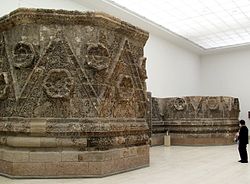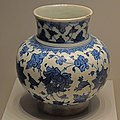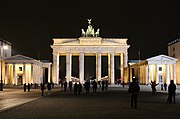art.wikisort.org - Museum
The Museum of Islamic Art (German: Museum für Islamische Kunst) is located in the Pergamon Museum and is part of the Staatliche Museen zu Berlin.
 Mshatta Facade in the Museum of Islamic Art | |
 | |
| Established | 18 October 1904 |
|---|---|
| Location | Berlin (Pergamonmuseum) |
| Type | Archaeology and Islamic art |
| Accreditation | Staatliche Museen zu Berlin (Stiftung Preußischer Kulturbesitz) |
| Director | Stefan Weber |
| Website | www |
Collection
The museum exhibits diverse works of Islamic art from the 7th century to 19th century from the area between Spain and India. Excavation activity in Ctesiphon, Samarra[1] and Tabgha, as well as acquisition opportunities, led to Egypt, the Foreign Orient and Iran in particular being important focal points. Other regions are represented by important collection objects or groups, such as the calligraphy and miniature painting from the Mughal Empire or the sicilian ivory works of art.
Important objects of the collection
Because of their size, art historical significance, or popularity with museum visitors, the most notable are:
- Mshatta Facade
- The Aleppo Room is the wall paneling from a broker's home in Aleppo, Syria, that was commissioned during the Ottoman Period.[2]
- Dome from the Alhambra[3][4][5]
- Mihrab from Kashan
- Mihrab from Konya
- Dragon-Phoenix carpet, Asia Minor, early 15th century.
- Koran-folding desk, Asia Minor (Konya), 13th century
- Book art (changing exhibition in the book art cabinets).
In addition to the permanent exhibition, the museum also shows exhibitions of modern art from the Islamic world, in 2008, for example, "Turkish Delight" (contemporary Turkish design) and "Naqsh" (gender and role models in Iran).
In 2009, the museum received on permanent loan a collection of Islamic art from the London collector Edmund de Unger (1918–2011), the so-called "Keir Collection", formerly housed in his home in Ham, Surrey. The collection, assembled over more than 50 years, comprises some 1,500 works of art spanning 2,000 years and is one of the largest private collections of Islamic art.[6] More than one hundred exhibits from the Keir Collection were first shown in 2007/2008 in the special exhibition Sammlerglück. Islamic Art from the Edmund de Unger Collection presented to the public at the Pergamon Museum. Another special exhibition with parts of this loan took place from March 2010 as part of the permanent exhibition of the Museum of Islamic Art entitled Sammlerglück. Masterpieces of Islamic Art from the Keir Collection.[7] In July 2012, the cooperation between the National Museums in Berlin-Prussian Cultural Heritage and the owners of the Edmund de Unger Collection was terminated and the collection, originally intended as a long-term loan, was withdrawn. The reasons given were differing ideas on how to continue working with the collection.[8]
- Collection Highlights
- Mshatta Facade (detail), Mid-8th century[9]
- Bowl from Abbasid Samarra, 9th century
- Samanid Simurgh Platter, 10th century
- Siculo-Arabic Ivory Casket, 11th century
- Signal horn (olifant) of ivory with figural decoration, Lower Italy or Sicily, 11th-12th century
- Mihrab from Kashan (detail), 1226
- Seljuk Koran folding desk, Mid-13th century
- Mihrab from Konya (detail), 13th century
- Wash Basin from Mosul, 1251 - 1275
- Pitcher from Mosul, 1251 - 1275
- Mamluk bottle with polo-playing riders (detail), c. 1300
- Ceiling from the Torre de las Damas (Alhambra), c. 1320
- Dragon-Phoenix carpet, Mid-15th century - 16th century
- Vase (Iznik pottery), 1st quarter of the 16th century
- Small Pattern Holbein carpet, 16th century
- Spiral Tendril Mughal Carpet (detail), 16th - 17th century
- Aleppo Room, 1600 - 1603 (detail)
- Emperor Jahangir at the gathering for the Eid al-Fitr, 1615-1625
History

The museum was founded in 1904 by Wilhelm von Bode as the Islamic Department in the Kaiser-Friedrich-Museum (today's Bode-Museum) and initially established by Friedrich Sarre as honorary director.[10] The occasion was the donation of the Mshatta facade, which originates from an unfinished umayyad desert palace located south of Amman by the Ottoman Sultan Abdülhamid II to Emperor Wilhelm II. Parts of the eastern portion of the facade and the ruins of the structure of which it formed a part remain in Jordan. Together with 21 carpets donated by Bode, the facade formed the basis of the collection. In the newly built Pergamon Museum, the museum moved into the upper floor of the south wing and was opened there in 1932. Because of II. World War, the exhibition was closed in 1939.
Despite the removal of artworks and the securing of objects remaining in the Pergamon Museum, the collection suffered damage and losses. A bomb hit destroyed one of the gate towers of the Mshatta façade, and an incendiary bomb burned all or part of valuable carpets housed in a vault at the Mint. In 1954 the collection was reopened as the Islamic Museum in the Pergamon Museum. The holdings that had been removed to the western occupation zones were returned to the museum in Dahlem, where they were also reexhibited in 1954 for the first time after the war. From 1968 to 1970, there was an exhibition in Charlottenburg Palace. In 1971, the permanent exhibition of the Museum of Islamic Art was opened in a new building in the Dahlem museum complex.
In 1958, the Islamic Museum in the Pergamon Museum on the Museumsinsel received back most of the artworks transferred to the Soviet Union from 1945 to 1946 as looted art. With the restoration of other important collection objects, it became possible to open all exhibition rooms to the public by 1967. Based on the Unification Treaty, the two museums were organizationally merged in 1992 under the name Museum of Islamic Art. At the Dahlem site, the exhibition closed in 1998. A newly designed permanent exhibition was opened on the upper floor of the south wing in the Pergamon Museum in 2000.
Directors
The history of the collection was significantly shaped by the respective heads and directors, who thus simultaneously influenced the development of Islamic art history in Germany.
| Wilhelm von Bode | 1904–1921 | ||
| Friedrich Sarre | 1921–1931 | ||
| Ernst Kühnel | 1931–1951 | ||
| Dahlem | Museum Island | ||
|---|---|---|---|
| Kurt Erdmann | 1958–1964 | Wolfgang Dudzus | 1959–1965 Director of the Islamic Museum |
| Klaus Brisch | 1966–1988 | Volkmar Enderlein | 1965–1971 acting director, 1971–1978 amt. Director |
| Michael Meinecke | 1988–1991 | 1978–1991 | |
| Michael Meinecke | 1992–1995 | ||
| Volkmar Enderlein | 1995–2001 | ||
| Claus-Peter Haase | 1 December 2001 – 31 January 2009 | ||
| Stefan Weber | since 1 February 2009 | ||
Exhibitions
Permanent exhibitions
- since 2000: Islamic Cultures[11]
- since 2016: transcultural relations, global biographies – Islamic art?[12]
Special exhibitions

2013[13]
- Samarra – Center of the World.
- Masterpieces from the Seraglio paintings from the adhesive albums of Heinrich Friedrich von Diez
- Affordable to many. Printed fabrics from Egyptian tombs.
- Ornament and tongue: book bindings from the Islamic world.
2014[14]
- Indulgence and Intoxication. Wine, tobacco and drugs in Indian paintings.
- Pride and Passion. Representations of men in the Mughal period.
- Mshatta in Focus. The Jordanian desert castle in historical photographs.
2015[15]
- Picnic in the Park. Gardens in Islamic Miniature Painting
- Aatifi – News from Afghanistan.
- How Islamic Art Came to Berlin. The collector and museum director Friedrich Sarre
2016[16]
- Mystical Travelers: Sufis, ascetics, and holy men.
- Reading words – feeling words An introduction to the Koran in Berlin collections.
- Contrast Syria. Photographs by Mohamad Al Roumi
- The Legacy of the Ancient Kings. Ctesiphon and the Persian sources of Islamic art.
2017[17]
- Iran. Dawn of Modernity.
- Faithful wonder – Biblical traditions in the Islamic world.
- Cozy: rugs in Indian miniature paintings.
2018[18]
- Perched | Stopover. An Installation by Felekşan Onar.
- Copy and Mastery.
- The Gallery in the Book. Islamic scrapbooks
- Tape Art
- With a sense of proportion. Masterpieces of architecture in Yemen
Research and outreach projects
Exhibition placement
- Fellowship International Museum of the Federal Cultural Foundation.
- Objects of Transfer
- Cultural Stories from the Museum of Islamic Arts
- Multaka: Treffpunkt Museum – Refugees as Guides in Berlin Museums
Research abroad
- Areia Antiqua. Ancient Herat / 3 projects
- Creation of digital cultural property registers for Syria
- Iran: The Provincial Museum Yazd / National Museum Tehran
- Qasr al-Mschatta: The Early Islamic Desert Castle of Mschatta, Jordan
- Reconstruction of an ancient cultural landscape in Baluchistan, Pakistan
- The Citadel of Aleppo, Syria
Cultural and political education
- Prevention of extremism and development of museum educational access for Muslim multipliers.
- Common past – common future
- TAMAM – The educational project of mosque communities with the Museum of Islamic Art
Collection-related research
- Khurasan – Land of the Sunrise
- Ctesiphon
- Samarra and the art of the Abbasids
- The Yousef Jameel Digitization Project
Bibliography
- Museum für Islamische Kunst (Hrsg.): Museum für Islamische Kunst. von Zabern, Mainz am Rhein 2001, ISBN 3-8053-2681-5.
- State Museums of Berlin Prussian Cultural Property: Museum of Islamic Art. von Zabern, Mainz am Rhein 2003, ISBN 3-8053-3261-0.
- Jens Kröger, Desirée Heiden (Hrsg.): Islamische Kunst in Berliner Sammlungen. 100 Jahre Museum für Islamische Kunst in Berlin. Parthas, Berlin 2004, ISBN 3-86601-435-X.
- Jens Kröger: Das Berliner Museum für Islamische Kunst als Forschungsinstitution der Islamischen Kunst im 20. Jahrhundert. (PDF; 692 kB). In: XXX. Deutscher Orientalistentag, Freiburg, 24.–28. September 2007. Ausgewählte Vorträge, herausgegeben im Auftrag der DMG von Rainer Brunner, Jens Peter Laut und Maurus Reinkowski. 2009. ISSN 1866-2943
- Stefan Weber: Zwischen Spätantike und Moderne: Zur Neukonzeption des Museums für Islamische Kunst im Pergamonmuseum. In: Jahrbuch Preußischer Kulturbesitz, Band XLVIII (2014), S. 226–257.
- Stefan Weber: Über uns und die anderen: Museen und kulturelle Bildung in der Islamdebatte. In: Jahrbuch Preußischer Kulturbesitz XLIX (2015), S. 88–109.
- Stefan Weber: Jeder kann Aleppo lieben. In: National Geographic, November (2016), S. 28–32 (Syrian Heritage Archive Project)
- Stefan Weber: Kampf um und gegen Kulturgüter im Nahen Osten – Das Fallbeispiel Syrien. In: BMVg.de: Der Reader Sicherheitspolitik, August (2016), S. 1–12 (Syrian Heritage Archive Project)
- Stefan Weber: Multaka: museum as meeting point. Refugees as guides in Berlin museums / Multaka: il museo come punto di incontro. I rifugiati come guide nei musei berlinesi. In: Archaeology & ME, Looking at archaeology in contemmpory Europe / Pensare l’archeologia nell’Europa contemporana. Bologna (2016), S. 142–45.
References
- samarrafinds.info: The archaeological finds from Samarra in Iraq
- Annette Hagedorn "Aleppo Room" in Discover Islamicart Art. Place: Museum With No Frontiers, 2010.
- The dome was brought to Berlin by Arthur von Gwinner in 1891 and given to the museum by his heirs in 1978. Jens Kröger: Alhambra Dome (2012). Museum With No Frontiers – Discover Islamic Art.
- Anna McSweeney: Arthur von Gwinner and the Alhambra Dome in Julia Gonnella and Jens Kröger (eds) Wie die Islamische Kunst nach Berlin Kam. Der Sammler und Museumsdirektor Friedrich Sarre (Berlin: Dietrich Reimer Verlag GmbH, 2015), 89–102.
- Alhambra-Dome. Deutsche Digitale Bibliothek
- Extensive Permanent Loan from the Edmund de Ungers Collection
- Haase, Claus-Peter (2007), A Collector's Fortune: Islamic Art from the Collection of Edmund de Unger, Hirmer Publishers, ISBN 978-3-7774-4085-9, distributed by Chicago University Press
- "press-release of July 13, 2012". Archived from the original on 7 May 2021. Retrieved 20 May 2021.
{{cite web}}: CS1 maint: bot: original URL status unknown (link) Staatliche Museen zu Berlin – Preußischer Kulturbesitz - Collection highlights listed in the museum site https://www.smb.museum/en/museums-institutions/museum-fuer-islamische-kunst/collection-research/collection-highlights/
- Jens Kröger: The Berlin Museum of Islamic Art as a Research Institution of Islamic Art in the 20th Century[dead link] (PDF; 692 kB). In: XXX. Deutscher Orientalistentag, Freiburg, 24–28 September 2007. Selected Lectures, edited on behalf of the DMG by Rainer Brunner, Jens Peter Laut, and Maurus Reinkowski, 2009, p. 10.
- Staatliche Museen zu Berlin. "Museum of Islamic Art: detail". Retrieved 20 July 2018.
- Staatliche Museen zu Berlin. "Museum of Islamic Art: SMB Exhibition: transcultural relations, global biographies – Islamic art? – transcultural relations, global object biographies, Islamic art, exhibition parcours". Retrieved 20 July 2018.
- Staatliche Museen zu Berlin. "Staatliche Museen zu Berlin: Museums & Institutions – Museum of Islamic Art – Exhibitions – Archive". Retrieved 20 July 2018.
- Staatliche Museen zu Berlin. "Staatliche Museen zu Berlin: Museums & Institutions – Museum of Islamic Art – Exhibitions – Archive". Retrieved 20 July 2018.
- Staatliche Museen zu Berlin. "Staatliche Museen zu Berlin: Museums & Institutions – Museum of Islamic Art – Exhibitions – Archive". Retrieved 20 July 2018.
- Staatliche Museen zu Berlin. "Staatliche Museen zu Berlin: Museums & Institutions – Museum of Islamic Art – Exhibitions – Archive". Retrieved 20 July 2018.
- Staatliche Museen zu Berlin. "Staatliche Museen zu Berlin: Museums & Institutions – Museum of Islamic Art – Exhibitions – Archive". Retrieved 20 July 2018.
- Staatliche Museen zu Berlin. "Staatliche Museen zu Berlin: Museums & Institutions – Museum of Islamic Art – Exhibitions – Archive". Retrieved 20 July 2018.
External links
- Literature by and about Museum für Islamische Kunst in the German National Library catalogue
- Museum für Islamische Kunst (Staatliche Museen zu Berlin)
- Museum of Islamic Art, Berlin in the Deutsche Digitale Bibliothek (German Digital Library)
- Museum für Islamische Kunst bei Discover Islamic Art
- Freunde des Museums für Islamische Kunst im Pergamonmuseum e.V.
На других языках
[de] Museum für Islamische Kunst (Berlin)
Das Museum für Islamische Kunst befindet sich im Pergamonmuseum und gehört zu den Staatlichen Museen zu Berlin.- [en] Museum of Islamic Art, Berlin
[fr] Musée d'Art islamique de Berlin
Le musée d'Art islamique de Berlin (en allemand : Museum für Islamische Kunst) se trouve à Berlin au musée de Pergame, situé à l'île aux Musées, et dépend des musées d'État de Berlin. Il est consacré à l'archéologie et à l'histoire de l'art islamiques. Il est dirigé depuis le 1er février 2009 par M. le docteur Stefan Weber.[ru] Музей исламского искусства (Берлин)
Музей исламского искусства в Берлине (нем. Museum für Islamische Kunst) размещается в Пергамском музее и входит в состав Государственных музеев Берлина.Другой контент может иметь иную лицензию. Перед использованием материалов сайта WikiSort.org внимательно изучите правила лицензирования конкретных элементов наполнения сайта.
WikiSort.org - проект по пересортировке и дополнению контента Википедии
![Mshatta Facade (detail), Mid-8th century[9]](http://upload.wikimedia.org/wikipedia/commons/thumb/3/36/Fachada_Mshatta_06.JPG/120px-Fachada_Mshatta_06.JPG)


















